Serviços Personalizados
Journal
Artigo
Indicadores
-
 Citado por SciELO
Citado por SciELO -
 Acessos
Acessos
Links relacionados
-
 Citado por Google
Citado por Google -
 Similares em
SciELO
Similares em
SciELO -
 Similares em Google
Similares em Google
Compartilhar
Ingeniería e Investigación
versão impressa ISSN 0120-5609
Ing. Investig. v.30 n.3 Bogotá set./dez. 2010
Luz Marina Torres P.1, Oscar F. Castellanos D.2, Claudia Nelcy Jiménez H.3
1Chemical engineer. M.Sc., in industrial engineering. BioGestión research group. Universidad Nacional de Colombia. lumatopi@gmail.com
2Chemical engineer. M.Sc. Technical Sciences. M.Sc., in Management. Ph.D. Chemistry, Universidad Estatal de Moscú. Postdoctoral studies in Biotechnology of enzymes. Professor Faculty of Engineering, Universidad Nacional de Colombia, Sede Bogotá. Coordinating Group for Research and Development Management, Productivity and Competitiveness, BioGestión. ofcastellanosd@unal.edu.co
3 Chemical engineer. M.Sc., Management, Ph.D., Candidate, Industrial Engineering, Universidad Nacional de Colombia. Professor School of Engineering Organization, School of Mines, Universidad Nacional de Colombia, Sede Medellín. Member of the research groups BioGestión and Innovation and technological management. cnjimenezh@unal.edu.co
ABSTRACT
Formalised intelligence systems in organisations lead to identifying their technological abilities/capabilities and changes in their environment by transforming data into knowledge having strategic value. Technology intelligence systems (TIS) have emerged, involving the suitable incorporation of technology into production and entrepreneurial systems, thereby enabling their management and generating the basis for developing innovation. This article describes the work involved in defining a subsystem allowing TIS implementation to be followed-up and evaluated. The evolution of technological intelligence was thus reviewed; the pertinent literature regarding measuring TIS efficiency was analysed. A model involving the system's main variables was then constructed; its simulation was based on implementing intelligence in several agro-industrial chains. The model's main contributions to optimum TIS performance were then considered.
Keywords: technology intelligence system, producing knowledge, decision-making, agro-industrial chains.
Received: september 4th 2009
Accepted: november 15th 2010
Introduction
Formal intelligence systems (economic, organisational, commercial, technological, competitive) have become positioned in organisations due to their versatility in identifying endogenous capacity and changes in pertinent settings by transforming data into knowledge having strategic value. Technology intelligence (TI) has been conceived as being the ability to identify technological developments in time and has also emerged as a model involving technological innovation-based market needs; this has led to distinguishing between technologybased fields regarding current technologies and technological fields of interest, which could be limited by future product functions and weak signals in technological trends (Lang and Mueller, 1997). Its main operating function consists of capturing and delivering information for developing knowledge about menaces and technological opportunities. Savioz et al., (2001) have defined a systematic model for compiling, analysing and disseminating information about the technical setting, aimed at finding new opportunities, coinciding with that proposed by Lang and Mueller (1997) who considered that a TI process is made up by formulating information needs, selecting sources of information, collecting data and evaluating such information.
There are many approaches to TI as a conceptual and methodologycal management scheme (Savioz et al., 2004); some work presents methods aimed at predicting future technological development, togethe with research into systems' development, leading to periodically observing an organisation's technological setting to evaluate its impact. A systemic vision and one regarding how intelligent processes promote organisational learning and generate decision-making ability should be included within the latter approach's framework for dealing with the concept of TI. TI could be interpreted as being, "how the capacity to carry out the process of searching for, managing and analyzing information, which on becoming transformed into knowledge, will lead to the suitable management of resources for designing, producing, improving and selling technologies for products and processes, through generating technological plans and strategies for relevant decision-making" (Castellanos and Jiménez, 2004; Castellanos et al., 2005a, Castellanos et al., 2005b; Castellanos et al., 2007, Castellanos, 2007, Torres et al., 2008). TI's dynamism and versatility has thus been attributed to being an instrument integrating tools which have traditionally been used independently, such as technological and prospective diagnosis, benchmarking, etc.
The authors of the present article have previously approached TI's conceptual development, its essential components, its generic and particular attributes, its epistemological specificities, its implementation structures and some cases of its being implemented. This article deals with evaluating the efficiency of applying TI, as this was seen as being a priority issue in the foregoing work.
The evolution of technological intelligence
Technological intelligence has become consolidated around the world as being a topic of growing interest. The available literature on the topic during the last ten years4 has led to two schools of thought being identified. The fist had been led by authors such as Kostoff, Tshiteya, Malpohl, Humenik, Karypis, Toothman and other members of the US Office of Naval Research who use the term technical intelligence; they have gradually increased their output of publications on topics such as analysing technologies through bibliometrics, database tomography and text mining (e.g. Kostoff et al., 1998; Kostoff et al., 2005). These methods allow scientific databases to be explored as well as the co-occurrence of words and phrases to be analysed for identifying developing technologies, nuclear skills and defining a sector or industry's technological route or roadmap for anticipating changes and supporting decision-making.
This initial approach to intelligence, very much linked to so-called technological surveillance, changed at the beginning of the second millennium with authors such as Norling (working as Dupont corporate technological assessor) who conceived the process as being technological intelligence, this being something more than scanning or surveillance for him. Such process deals with information about scientific and technological developments affecting a company's competitive position and consists of four stages distinguishing them as being an intelligent process (Norling et al., 2000): planning, organising and directing competitive intelligence efforts, intelligent information collection, analysing data and disseminating results.
This second school includes many authors, such as Lichtenthaler, who has been working on the topic since 2004. He has stated that of (Lichtenthaler, 2003, Lichtenthaler, 2004a, Lichtenthaler, 2004b, Lichtenthaler, 2007) implementing TI depends on an organisation's decision-making style and its culture. He has also stated that TI activities' distribution and size are conditional on decision-making's place within innovation activities. He has also referred to the types of TI coordination (structural, hybrid and informal) and mentioned that the quality of a TI process influences technology management effectiveness, for example, acquiring information about technological trends. Lichtenthaler et al., (2009) introduced a new concept, technology commercialization intelligence, referring to observing a particular setting and placing special emphasis on identifying technological licencing opportunities.
The IT school has the longest trajectory, whilst the second (having been in existence for just 10 years), has begun to position itself by dealing with topics such as knowledge and intelligent strategies and processes. It should be stressed that common topics such as capacities/ abilities, forecasting and innovation can be considered articulator axes for both schools.
Being the sum of methods, processes, best practices and tools, TI provides a response to the changing business setting and technological developments or trends which can influence an organisation's competitive position (Chang et al., 2008). However, its implementation must result from an organised effort (Lichtenthaler, 2004c), meaning that Norling et al., (2000) recommended using sophisticated means for compiling and analysing information, transporting intelligence to those who can act on it and use individuals having the experience, abilities and correct temperament for developing it. Likewise, it must be born in mind that quality of information has different categories and its evaluation leads to detecting errors (Berti,1999).
The background to measuring the impact of intelligence processes
Lönnqvist and Pirttimäki (2006) posed the need for clearly differentiating the concept of value within this context for establishing an intelligence process's (not necessarily technological) value or impact depending (in most cases) on subjective appreciation and needs, or which could be evaluated in terms of improving perceived usefulness. Intelligence systems do not have value as such, as value results from using intelligence. These authors have stated that analysing two basic questions can lead to establishing the value or impact of an intelligence process. How much does it cost to apply an intelligence system? What are the benefits of applying an intelligence system? They thus indicate that operating resources, initial investment capital and labour costs regarding information and other expenses must be counted in implementing intelligence systems; however, not all of an intelligence system's benefits can be measured by costs and many effects are not financial or intangible such as response quality and time with updated information.
The competitive intelligence measurement model (CIMM) proposed by Davidson (2001) is one of the developments for measuring intelligence systems' impact; this can be used for calculating investment return on competitive intelligence, considering that the value of competitive intelligence (CI) is equal to the sum of CI projects and that CI output is the result of the effects of achieving CI system objectives added to the satisfaction of taking decisions. Return on investment in CI can thus be calculated as being the difference between CI system output and input divided by system input (known as ROCII). However, the ROCII calculation may not be so reliable since it includes qualitative evaluations.
Elbashir et al., (2008) have mentioned that it is not very appropriate to use accounting measurements such as company profitability or the return on investment when measuring business performance based on tools such as transactional processing systems or decision-making support systems. They argue that such measurements are often not very consistent with a company's strategic intention regarding technology and are not sufficiently close to the influence or benefits of applying such systems. Lönnqvist and Pirttimäki (2006) have analysed strategies for evaluating the efficiency of applying intelligence systems by taking up previous work (Table 1 ).
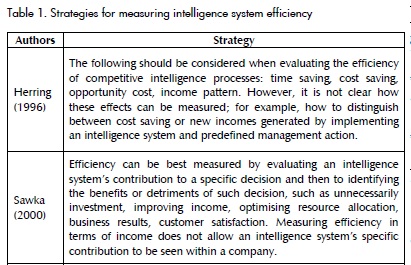
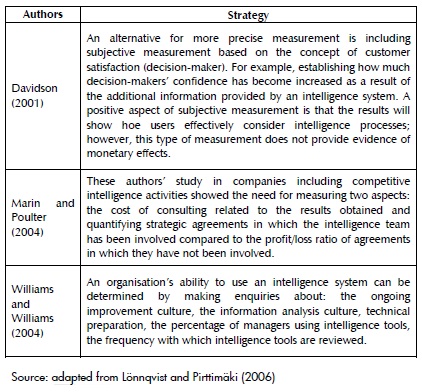
Model for measuring TIS efficiency
A technological intelligence system (TIS) involves transforming elements, consumables or environmental stimuli (input) into results (output), these usually being intangible. This characteristic makes it possible to conceive it as being a production process whose main input is knowledge and information and its main output is intelligence, this being decision-making capacity within a technological environment, having a strategic impact on organisational management. This production process has the characteristics of knowledge-intensive services, since they involve interaction between a service provider (searching for, processing, analysing information and broadcasting knowledge) and decision-makers or people consuming a particular service.
Identifying the TIS value chain is an indispensable step in establishing possible evaluation and follow-up mechanisms. Such analysis is compatible with the approaches described in Table 1, since it shows the need for identifying the consequences for a company of implementting the strategies generated by the system, as well as the impact on an organisation as measured by customer satisfaction. Regarding the first aspect, defining indicators will depend on an organisation's vision and the objectives pursued by applying TI, meaning that they must be individually established for each case and they can only be measured after a period of time has elapsed. Concerning measuring impact, customer satisfaction will be evaluated (i.e. decision-making and strategy-generating capacities). Table 2 presents the main variables,considering the most important elements for each link in the TIS value chain. One of the indicators allowing TIS impact to be evaluated is service processing time which must not exceed the level allowed by a customer/client (Powell et al., 2001). Ojasalo (2003) has also stated that client constitutions will depend on the type of service which is being provided, or even on those occasions when a client does not have clear expectations but defines the characteristics which he/she expects to receive through interaction with the service provider.
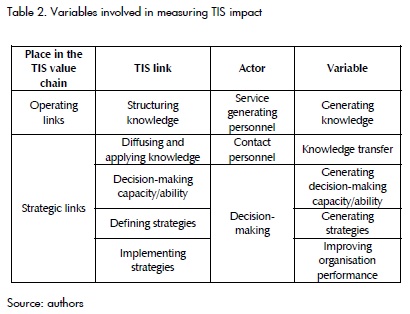
Evaluating and following-up TIS
A TIS evaluation and follow-up subsystem is proposed for describing and analysing such system's behaviour and thereby evaluating its efficiency. A model was formulated to represent it which responded to the problem expressed as follows. How can decision-making capacity/ ability and good strategy formulation be increased by implementing TI systems?
The variables and their pertinent connections were then identified, taking into account that providing TI services involves two actors: the service provider and the user; the most relevant aspect for the former is achieving efficient resource use, thereby achieving the expected result, whilst a user seeks an impact on an organisation, such as sustainability by incorporating decision-making capacities/ability. These goals led to identifying two approaches for the measurement subsystem: process management and the impact of its implementation. Each approach manages different variables, as they have different evaluation and follow-up purposes.
Input and output variables were established by taking the influence exercised by each actor on the service provider in managing the process and on the impact of applying TIS as reference. Basic service provider actors could, in turn, cover other actors and contain other elements, as in the case of the service provider involving contact personnel, service generating personnel, as well as the information managed by them. Table 3 shows the variables so identified.
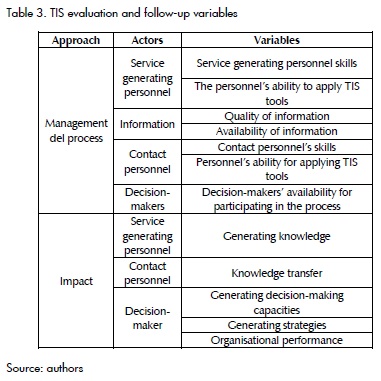
The number of interrelationships between variables and the number of feedback and delay cycles were established as suggested by Spector et al., (2001).Figure 1 presents the relationships between the variables so identified. This interpretation was structured based on the authors' experience in accompaniment and consultancy for implementing TI at different organisational levels in Colombia: manufacturing companies, sectors such as biotechnology, flexible plastic packaging and software and associated services and production chains such as the cacao-chocolate chain, cosmetics and cleaning products, domestic appliances, sisal, rubber and brown sugarloaf.
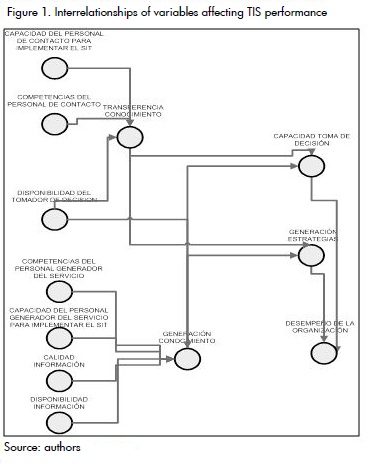
Any system's performance is usually followed-up and evaluated by using a performance measurement framework, consisting of several individual measurements or indicators. Even though there are many models such as the balanced scorecard, the performance prism or the performance pyramid, the chosen measurements must be based on an organisation's vision and strategy (Okkonen et al., 2002). The need for having a model which does not contradict the real system's knowledge must be added to this, meaning that the structure must be verified (Luna and Lines, 2003). Forrester (1988) has stated that a model's variables must be measured using the same units as those of real variables; seven cases of implementing TIS in agro-industrial production chains (cacao-chocolate, tobacco, African palm, sisal, cotton, beef and chilli-pepper) were thus taken for establishing the units which should be used in a TIS evaluation and follow model, considering that most variables were qualitative. Table 4 presents the scale for measuring one of the variables defined in the model.
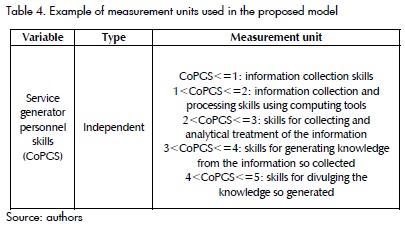
Simulating a model for evaluating TIS efficiency
The proposed model was simulated and validated by Torres (2010), thoroughly explained by input data, considerations and values regarding the proposed indicators. The representation of the measurement and follow-up subsystem was adjusted to the characteristics of the variables so identified as being independent and dependent, and specific interaction, knowledge management and intelligence management variables were added. A model of the subsystem was simulated with Stella 8.0 software using data from the aforementioned seven agro-industrial chain case studies. It should be mentioned that this software is used for simulating dynamic systems and, even though the subsystem being modelled did not present changes over a period of time, it did have feedback between its variables, meaning that this software facilitated analysing it.
Improving TIS implementation
Simulating and validating the model for evaluating TIS efficiency led to establishing several aspects orientated towards improving its implementation in organisations based on influential variables regarding this system's performance. Information, as raw material in the intelligence process, must have the highest standards; however, in the case of organisations whose structure hampers the existence of quality information, then prior studies will be needed to guarantee its availability. Decision-makers' attitude will lead to generating vectors of knowledge and foster decision-making capacities/ability. This means that when there is no desire to participate at this level of an organisation, the best thing is to re-evaluate the need for implementting TI at a given moment. Organisational culture and the management of change must thus be analysed as this could reveal problematic situations for a particular organisation which must be dealt with prior to implementing a TIS. Both foregoing aspects show that implementing TIS is influenced by the context's specificity, meaning that prior stages will be needed so that an organisation is sufficiently prepared for TIS to function satisfactorily. Obtaining satisfactory results when implementing TI will result from the interaction between decision-makers and service providers, individual variables' satisfactory performances being insufficient.
Conclusions
TI has become consolidated as a management topic having great relevance in research; however, it has become positioned as a knowledge service provided by research centres and consulting companies. Given the amount of resources needed for implementing TI systems in different settings, it has become necessary to establish the impact of achieving and evaluating such systems' efficiency. Nevertheless, such evaluation cannot be measured in just quantitative terms as many of the impacts and benefits are expressed in quailtative aspects such as strengthening an organisation's capacities/abilities and achieving better information flow and exploiting it for generating knowledge. The proposed model is considered novel in the sense that it is proposed as a new TIS subsystem (not yet having been considered by other authors) and is defined by qualitative variables allowing TI contributions and benefits to be measured regarding both process management and the impact of its being implemented.
Validating this TIS follow-up and evaluation subsystem model revealed high correlation with results obtained in practical cases, showing the validity of the premises and the model's coherence, in turn, leading to some considerations being proposed for improving TIS implementation, basically orientated towards preparing organisations so that the results of TI processes should be satisfactory.
Berti, L., Quality and recommendation of multi-source data for assisting technological intelligence applications., Lecture notes in computer science, 1677, 1999, pp.282-291 [ Links ]
Castellanos, O. F., Gestión tecnológica: de un enfoque tradicional a la inteligencia., Editorial: Universidad Nacional de Colombia, 2007, ISBN 958-701-685. [ Links ]
Castellanos, O. F., Jiménez, C. N., Importancia de la inteligencia en la gestión tecnológica de las organizaciones contemporáneas., Memorias del XXIII Simposio de Gestión de la Innovación tecnológica, Brasil, 2004. [ Links ]
Castellanos, O. F., Torres, L. M., Rosero, I. J., Modelo estructurado de inteligencia tecnológica para la generación de conocimiento y la direccionamiento estratégico del sector productivo., Memorias del IX Congreso Anual de la Academia de Ciencias Administrativas ACACIA, México, 2005a. [ Links ]
Castellanos, O. F., Rosero, I. J., Torres, L. M., Jiménez, C. N., Aplicación de un modelo de inteligencia para definición de estrategia tecnológica en diferentes niveles de complejidad institucional., Memorias del XI Seminario Latino Iberoamericano de Gestión Tecnológica ALTEC, Brasil, 2005b. [ Links ]
Castellanos, O. F., Torres, L. M., Fonseca, S. L., Montañez, V. M., Sánchez, A. P., Agenda prospectiva de investigación y desarrollo tecnológico de la cadena productiva de cacao-chocolate., Ministerio de Agricultura and Desarrollo Rural, 2007. [ Links ]
Chang, H., Gausemeier, J., Ihmels, S., Wenzelmann, C., Innovative technology management system with bibliometrics in the context of technology intelligence., Trends in Intelligent Systems and Computer Engineering, 2008, pp.349-349 [ Links ]
Davison, L., Measuring competitive intelligence effectiveness: insights from the advertising industry., Competitive Intelligence Review, 12 (4), 2001. [ Links ]
Elbashir, M. Z., Collier, P. A., Davern, M. J., Measuring the effects of business intelligence systems: The relationship between business process and organizational performance., International Journal of Accounting Information Systems, 9 (3), 2008, pp.135-153 [ Links ]
Forrester, J. W., Dinámica Industrial., Editorial Ateneo, Buenos Aires, 1988. [ Links ]
Kostoff, R. N., Eberhart, H. J., Toothman, D. R., Database tomography for technical intelligence: A roadmap of the near-earth space science and technology literature., Information Processing & Management, 34 (1), Jan.,1998, pp.69-85. [ Links ]
Kostoff, R. N., Tshiteya, R., Pfeil, K. M., Humenik, J. A., Karypis, G., Power source roadmaps using bibliometrics and database tomography., Energy, 30 (5), Apr.,2005, pp.709-730. [ Links ]
Lang, H.C., Mueller, M., Technology intelligence identifying and evaluating new technologies, Innovation in Technology Management - The Key to Global Leadership., PICMET'97: Portland International Conference on Management and Technology, 1997. [ Links ]
Lichtenthaler, E., Third generation management of technology intelligence processes, R&D Management, 33 (4), 2003, pp.361-375. [ Links ]
Lichtenthaler, E., Coordination of technology intelligence processes: A study in technology intensive multinationals., Technology Analysis & Strategic Management, 16 (2), 2004a, pp.197-221. [ Links ]
Lichtenthaler, E., Technological change and the technology intelligence process: a case study., Journal of Engineering and Technology Management, 21 (4), Dec., 2004b, pp.331-348. [ Links ]
Lichtenthaler, E., Technology intelligence processes in leading European and North American multinationals., R & D Management, 34 (2), 2004c, pp.121-135. [ Links ]
Lichtenthaler, E., Managing technology intelligence processes in situations of radical technological change., Technological Forecasting and Social Change, 74 (8), Oct., 2007, pp.1109-1136. [ Links ]
Lichtenthaler, U., Lichtenthaler, E., Frishammar, J., Technology commercialization intelligence: Organizational antecedents and performance consequences., Technological Forecasting and Social Change, 76 (3), Mar., 2009, pp.301-315. [ Links ]
Lönnqvist, A., Pirttimäki, V., The measurement of business intelligence., Information System Management Journal, 23 (1), 2006, pp.32-40. [ Links ]
Luna, L., Lines, D., Collecting and analyzing qualitative data for system dynamics: methods and models., System Dynamics Review, 19 (4), 2003. [ Links ]
Norling, P. M., Herring, J. P., Rosenkrans, W. A., Stellpflug, M., Kaufman, S. B., Putting competitive technology intelligence to work, Research-Technology Management, 43 (5), 2000, pp.23-28. [ Links ]
Ojasalo, K., Customer influence on Service Productivity., Advance Management Journal, 68 (3), 2003, pp.14-19. [ Links ]
Okkonen, J., Pirttimäki, V., Hannula, M., Lönnqvist, A., Triangle of business intelligence performance measurement and knowledge management., Tampere University of Technology, Finland, 2002, consulted on the 12th November 2009. Available at http://www.tut.fi/units/tuta/teta/mittaritiimi/julkaisut/tukholma.pdf [ Links ]
Powell, S., Schwaninger, M., Trimble, C., Measurement and control of business processes., System Dynamic Review, 17 (1), 2001, pp.63-91. [ Links ]
Savioz, P., Luggen, M., Tschirky, H., Technology intelligence, Structuring it into the new-technology-based firm (NTBF)., Tech Monitor, Heft, Jul-Aug, p. 41-46, 2004. [ Links ]
Savioz, P., Scacchi, M., Tschirky, H.P., Implementing a technology intelligence system in a medium-sized medtech company., 2001. [ Links ]
Spector, M., Christetnsen, D., Sioutine, A., Mrccormack, D., Models and simulations for learning in complex domains: using causal loop diagrams for assessment and evaluation., Computers in Human Bahavior, 17, 2001, pp.517-545. [ Links ]
Torres, L. M., García, M. E., Castellanos, O. F., La inteligencia tecnológica como capacidad para las tomas de decisiones estratégicas., En: Retos y nuevos enfoques en la gestión de la tecnología y el conocimiento, Universidad Nacional de Colombia, 2008, pp.131-173. [ Links ]
Torres, L. M., Definición de un sistema de evaluación y seguimiento de los componentes del sistema de inteligencia tecnológica., MSC Industrial Engineering thesis, Universidad Nacional de Colombia, Bogotá, 2010. [ Links ]











 texto em
texto em 


